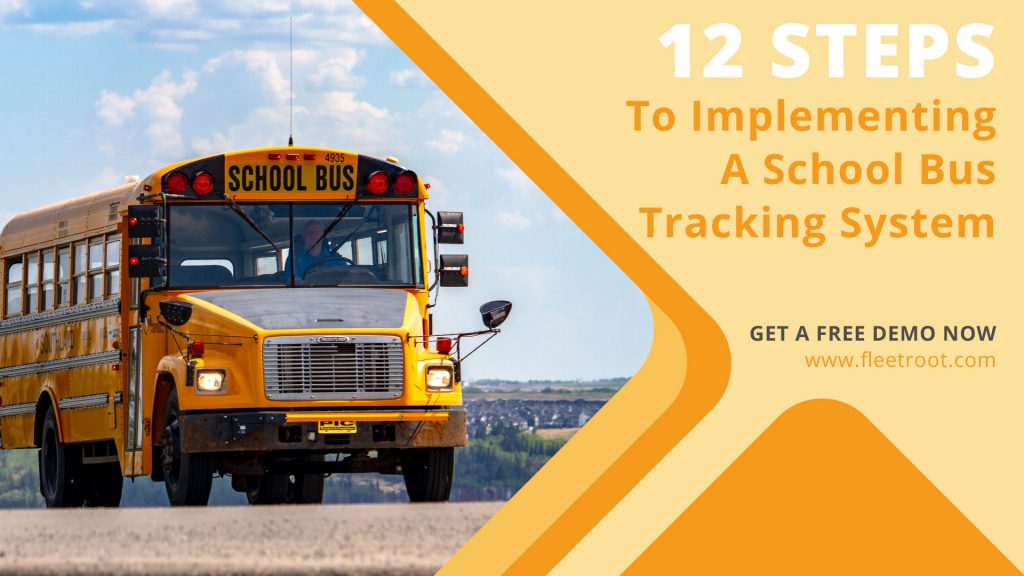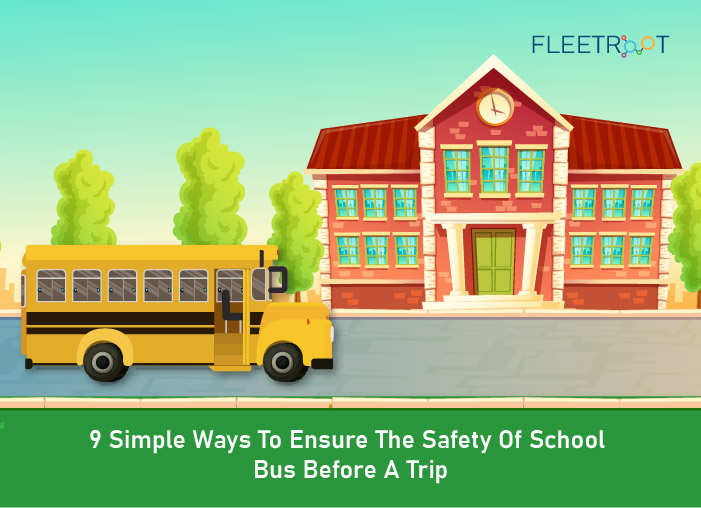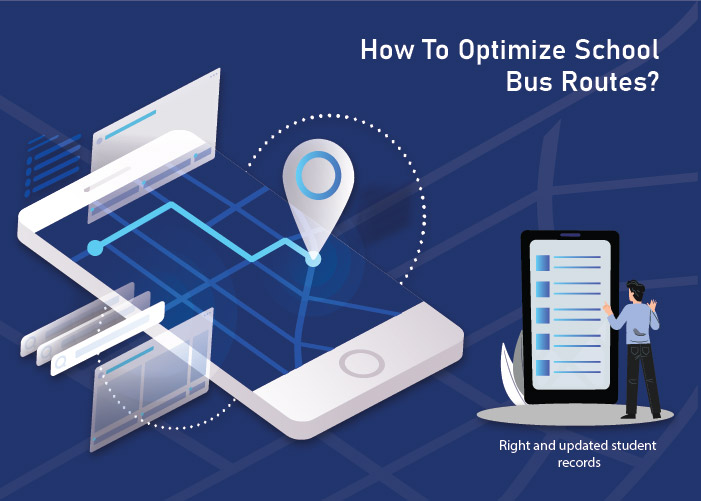Even though school buses are supposed to be the safest mode of transport for school children, incidents of accidents, fire, and crimes against school children are on a rise across the world.
Many countries have mandated the use of GPS tracking in school buses.
If you are considering using a GPS Tracker to track your school buses, here is a simple step by step guide to implementation.

1.Get Clear on Your Goals:
Before you get started, be clear on what you want to achieve by implementing the tracker. Are you simply looking to track the school bus in real time and notify all concerned about arrival times, route deviations etc., or do you also want to keep a track of students and their whereabouts?
What about CCTV cameras? Do you think they will add value?
Besides safety, are you also looking to optimize your routes and save on operational costs? Do you also need to monitor your drivers?
Simply speaking, with GPS tracking, the possibilities are many – but as an essential first step, you need to decide what is important for you, depending on your specific requirements and budget.
2.Prioritize Your Stakeholders:
Typically, the stakeholders for a school transportation business are school authorities, parents, transport managers, teachers, drivers and law enforcement/ regulatory bodies.
Depending on your goals, you need to decide how important each of these stakeholders are for your business, and accordingly invest into hardware and software to meet each of their concerns.
E.g., you may decide to offer a dedicated app to parents with many features that will help them track their child’s school bus and ensure that they are safe on the commute.
Or, if your locality has many incidents of illegal passing, you may decide to invest in sophisticated stop arm cameras so that you can report details of such incidents to law enforcement.
3.Choose Your Hardware:
First and foremost, you need a GPS tracker device.
GPS Tracker: There are many devices in the market, but ideally, you need something that has a wide input voltage support so that it can work smoothly once you connect it to the electric circuitry of your bus. You need a SIM card and a minimum monthly data plan of 150 MB to get started.
Nowadays GPS devices for school buses come with a host of features such as real time tracking, speed monitor, SOS button, shock sensor, vibrational alarm, accident detection, voice surveillance, ignition cut-off etc.
Next, depending on your goals and priorities, you can decide on what other hardware you want to invest in, e.g., RFID scanners and ID cards for student monitoring, CCTV cameras, Video surveillance equipment etc.
4.Implementing a Basic GPS Tracking System:
Once you have installed the GPS devices in your buses, you simply need to scan a QR code to download a tracking app, or you can login into the tracking device website to start tracking your school buses in real time on a map.
School authorities can track the distance covered as well as speed of the buses.
They can create bus routes, set up geofences for routes, bus stops and destinations, and receive alerts for deviations and speeding incidents. They can also look at route history and analyze basic reports for on- time performance and more.
5.Implementing School Bus Routing software:
In order to automate the routing process, you need to first enter / import all student addresses in the system and specify either the number of routes, the maximum route duration, or the maximum stops per route. You also need to specify your optimization goal – minimize time/ minimize distance or a balance of both.
Once done, the system creates the most efficient routes for your school buses, which will help you save on time, fuel costs and over-heads. These routes will be dynamic and change instantly in response to an address change or if a student is absent etc.
6.Implementing Basic Student Tracking:
In order to track students’ attendance on the bus, the children need to be equipped with some sort of a smart device (e.g., key fob/ smart watch/smart phone etc.), through which the system logs their attendance.
The school bus attendant uses an attendance app, on which student names are ticked as they enter or exit the bus, and all concerned get instant notifications via SMS.
The application will have a driver console through which the driver receives route as well as student details, and manages multiple tasks.
All concerned will also get push notifications on expected arrival and departure times, and also get instant alerts in the event of any emergency, or if the student fails to get on the bus, gets down on the wrong stop etc.
7.Implementing Advanced Student Tracking:
This incorporates the use of radio frequency ID cards (RFID cards) for the children, which are uniquely coded for every child.
Typically, this automated student attendance system is implemented on school buses as well as various points inside the school premises, so the corresponding scanners have to be installed on each of these locations.
Teachers no longer need to take attendance separately in class -the system takes care of it.
Parents, teachers and school authorities can have a much better visibility of the whereabouts of the children- whether they are on their way to school, attending a class, in the playground etc.
Incase a student deviates from the plan, boards the wrong bus or leaves the school premises during the break, all concerned will be immediately notified.
8.Customized Apps:
Parents can have an app through which they can easily track the school bus, receive notifications for over speeding, route deviations, delays etc.
They can also communicate with drivers and school authorities and make changes in on-boarding or off-boarding stops for their child at any time and the same will be instantly communicated to the driver.
Transport Managers can have an app through which they keep track of all the buses, drivers, routes, fuel costs, maintenance etc. and manage the whole transportation process efficiently.
Similarly, school authorities as well as teachers can be equipped with customized apps.
9.Implementing School Bus Surveillance:
This could incorporate the use of high resolution wide angled CCTV cameras to cover the entire inside of the bus as well as all four sides of the bus.
This will discourage bullying and also help drivers and school authorities ensure that children are commuting in a safe environment. In the event of an accident, these cameras will also help to identify the source of the problem.
Drivers can get alerted if small children are standing on the side of the bus or are yet to cross the road, so they can ensure that the way is clear before restarting the bus.
You can also set up smart IP video cameras for video surveillance so that school authorities can access live video streaming from inside the bus.
10.Implementing Preventive Maintenance:
A good school bus tracking system will allow for transport managers to set up maintenance schedules for each school bus to check on oil changes, tire rotations, engine tune ups etc. on a regular basis. Additionally, drivers can be required to conduct pre and post trip checks of the school bus.
Automating / digitizing the above two processes ensures that the driver is carrying out the tasks diligently and not rushing the process. The end result – school buses are always road-worthy and breakdowns / downtime are avoided.
11.Implementing Driver Monitoring:
Since maximum accidents are caused by driver negligence, drivers need to be monitored for over speeding, hard braking or rash maneuvering. Alerts can be set up to notify key stakeholders every time the drivers resort to irresponsible driving practices.
Drivers can also be monitored for Idling the engine more than necessary, which leads to fuel wastage as well as pollution.
You can also set up a driver score card system that automatically tracks deviations, so that erring drivers can be trained and those who perform well can be rewarded.
12.Implementing Advanced Sensors:
IOT based sensors and alerts can be set up to cover important functionalities of the school bus, and provide even greater control. E.g. alerts could be sent out if a defect is flagged during a post trip check, if the check engine light comes on or if the stop arm is not functioning.
Sensors on the fuel tanks could keep track of when where and how much fuel was filled in the fuel tanks. This would help to monitor fuel spends and prevent unauthorized use of the buses.
Conclusion:
Thus, whether you are a school or a school transportation provider with a fleet of buses, you can implement a school bus GPS tracking system that is perfectly suited for your requirements, and one which can also be scaled up as you grow your business.
Each successive step in this guide brings you closer to achieving your goals to the fullest- be it greater safety for students, more efficient operations or peace of mind for parents.
What is your opinion? Do let us know by commenting below.


